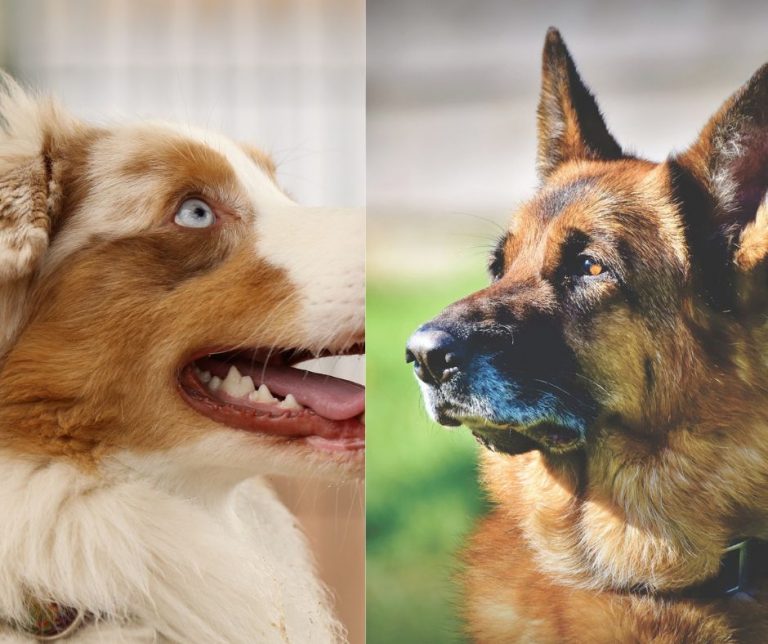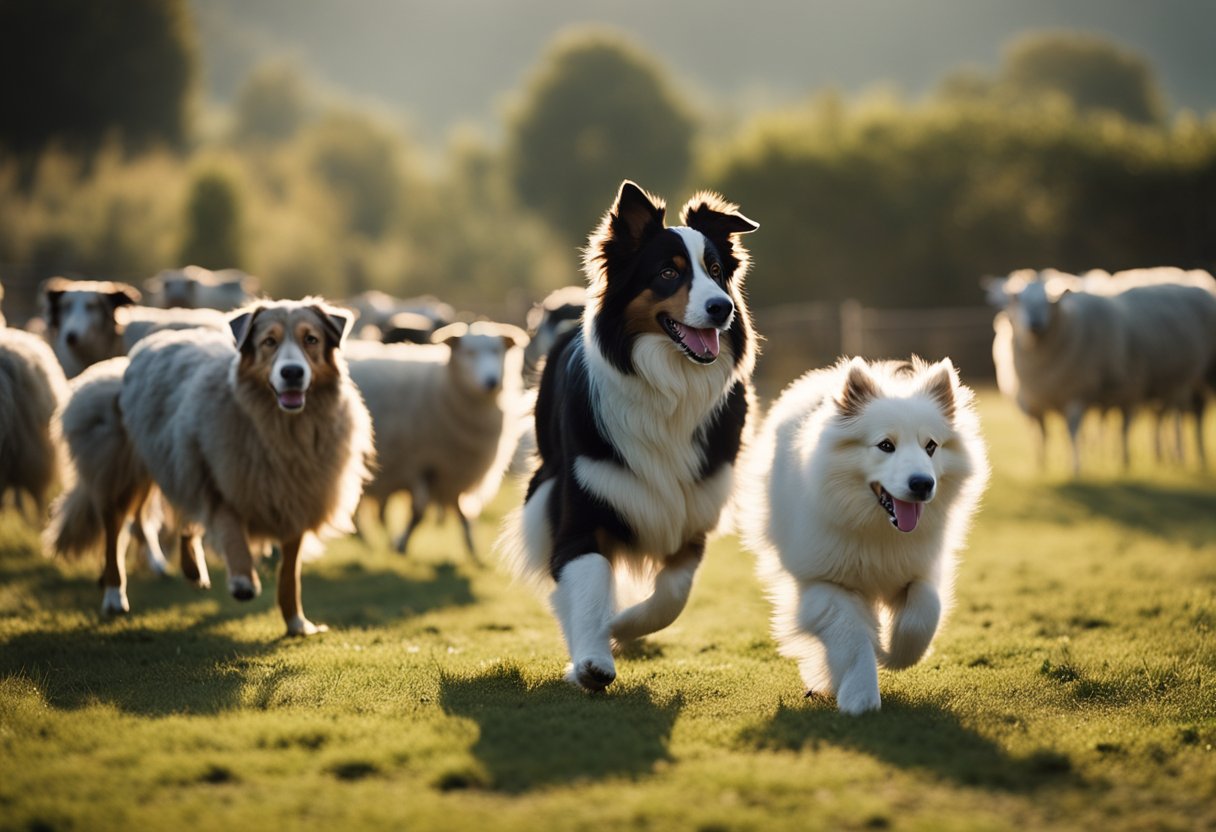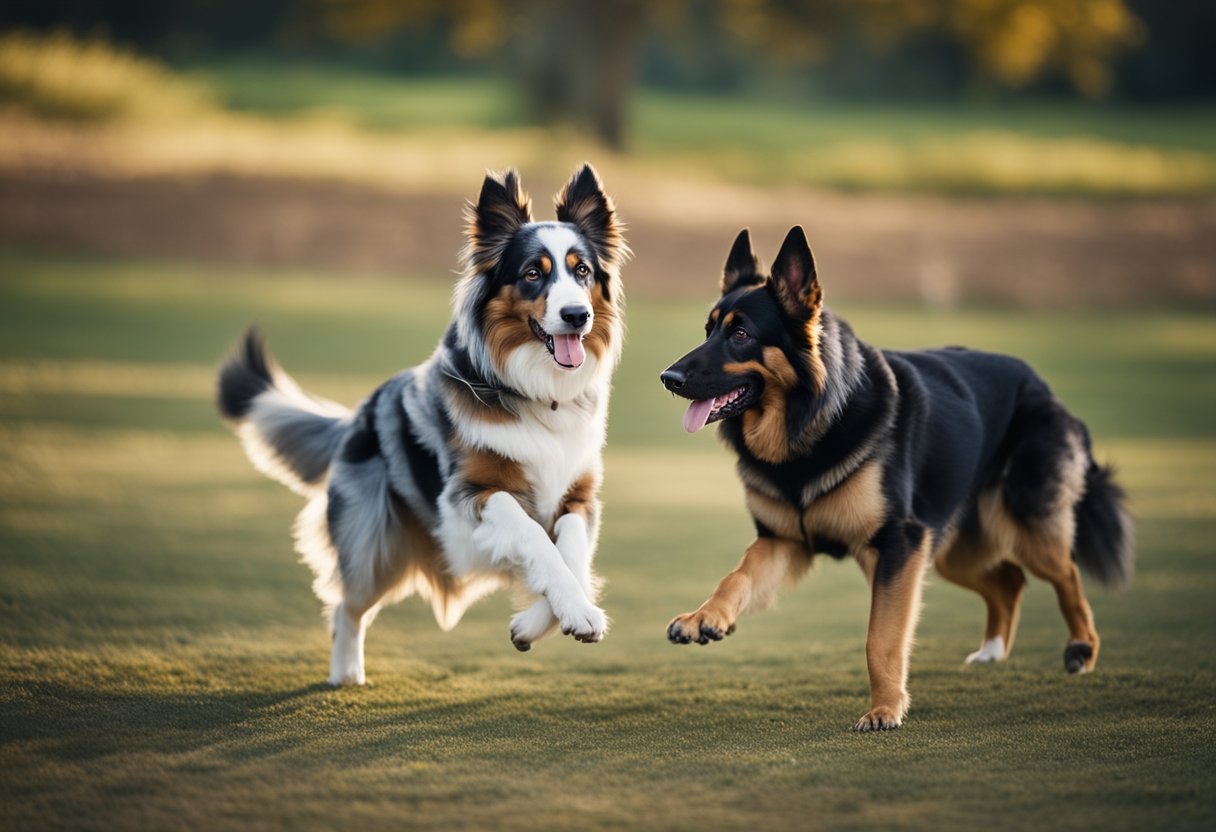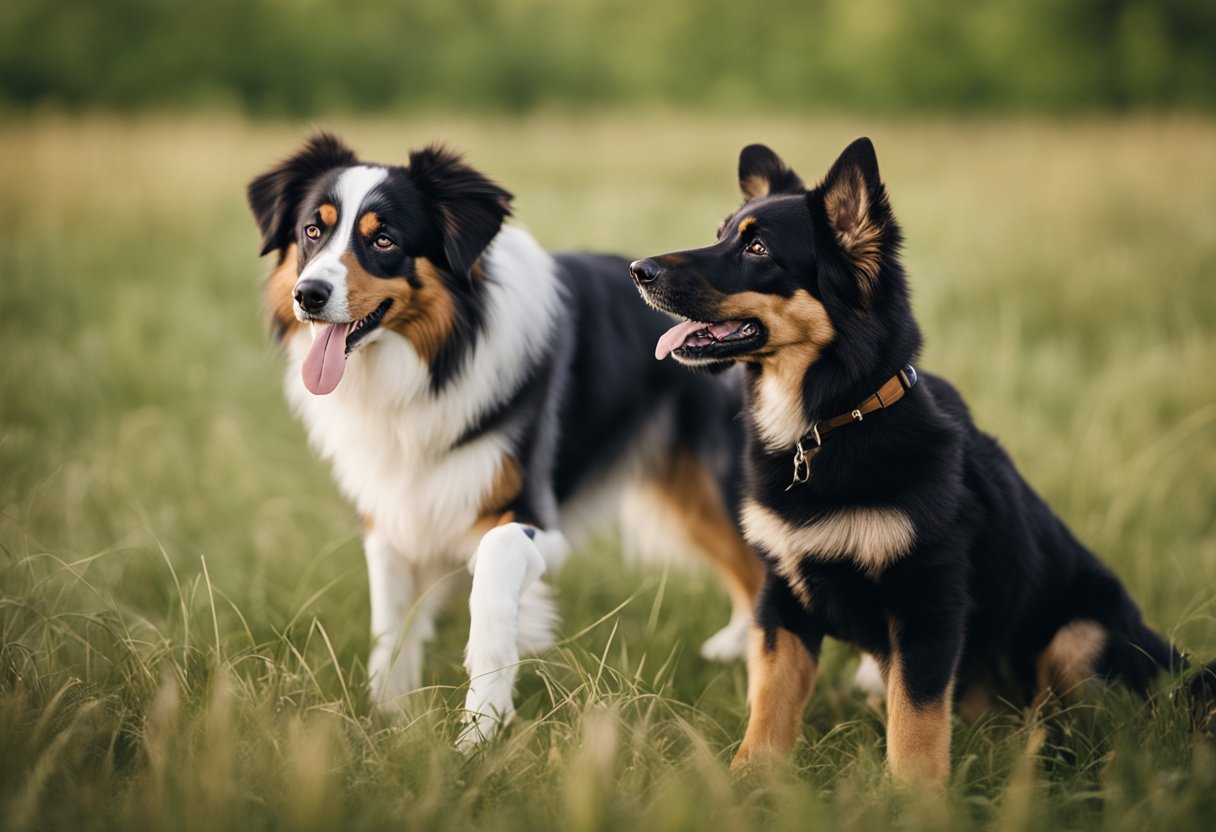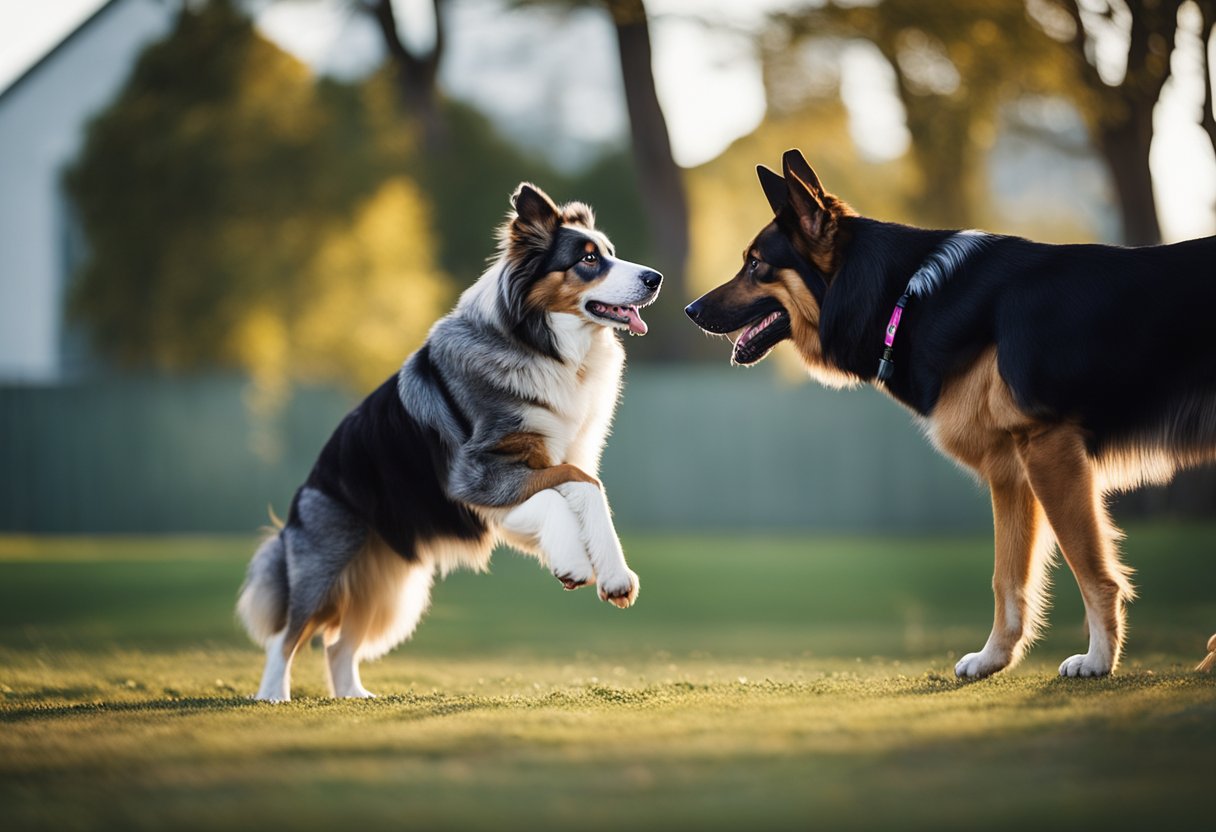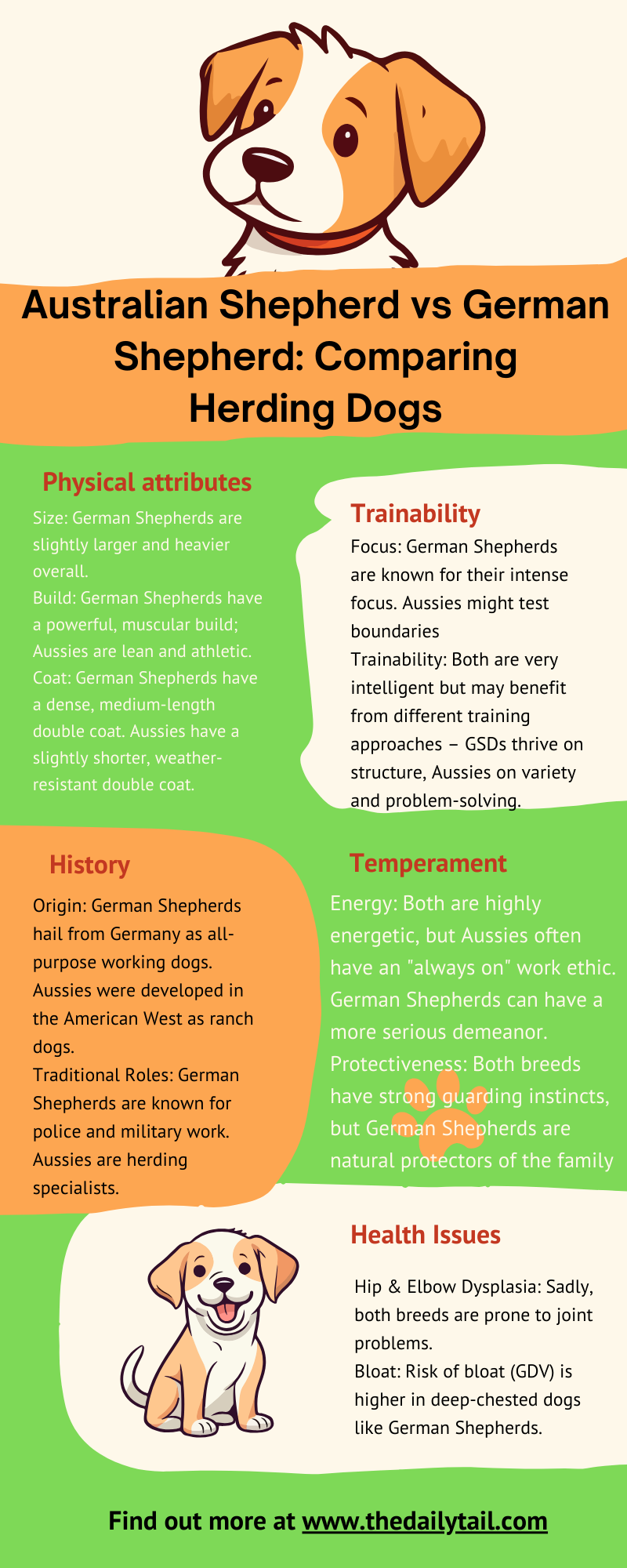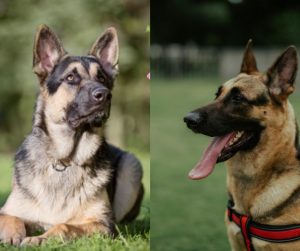When comparing the Australian Shepherd vs German Shepherd, it is important to account for the unique characteristics that define each dog breed. On one hand, the Australian Shepherd dog breed, known for its intelligence and agility, is an active herding dog that thrives on mental and physical exercise. Originating in the western United States, they have become a popular choice for families and individuals alike due to their versatility and affectionate nature.
Typically, they weigh between 35 to 70 pounds, and their life expectancy ranges from 13 to 15 years. They often have a striking coat with potential for heterochromia, which gives them their distinctive appearance.
On the other hand, the German Shepherd dog breed stands as a symbol of diligence and loyalty. Originating from Germany as a herding dog, this breed has been extensively employed in various roles, such as police and service work, owing to their strength, intelligence, and obedience.
They are typically larger in size compared to the Australian Shepherd, with males often weighing between 65 to 90 pounds. German Shepherds have a life expectancy of around 9 to 13 years and are known for their dense double coat which requires regular grooming to maintain their health and appearance.
Understanding the temperament and care needs of Australian and German Shepherds is crucial for potential owners. The Australian Shepherd is family-friendly, adapts well to a variety of settings, and tends to be more vocal, whereas the German Shepherd emanates a confident calmness and can be protective, making them excellent guardians.
Both breeds demand active engagement and training, reinforcing their position not only as pets but as valuable working companions. The right choice between the two ultimately depends on an individual’s lifestyle, space, and the time they can devote to their furry companion.
As someone who’s shared my life with dogs, I know the appeal of the ‘Shepherd’ breeds. But choosing between the Aussie and the German Shepherd depends on the details. Let me guide you through the Australian Shepherd vs German Shepherd dog breed comparison.
Breed Overview
In comparing the Australian Shepherd vs German Shepherd dog breed comparison, it’s important to consider their origins, the breadth of their popularity, and their recognized breed classifications. Each breed reflects a storied history of development as a working dog, with unique characteristics honed for specific herding tasks. Both were bred as a herding dog, but have now grown into popularity as a family pet. Both are recognized by the American Kennel Club as part of the herding dog group.History
Australian Shepherd: Despite its name, the Australian Shepherd, or Aussie, was actually developed in the Western United States during the 19th century. They were bred for their versatile herding skills and have no verified historical links to Australia.
German Shepherd: Originating from Germany in the late 19th century, German Shepherds were bred by Max von Stephanitz who sought to standardize herding dogs. They quickly transcended their herding origins to become valuable working dogs in various roles.
Popularity
Australian Shepherd: The Aussie’s agility and intelligence have earned them a dedicated following, especially among families and on ranches. They are also a popular choice for many canine sports.
German Shepherd: Renowned for their versatility and intelligence, the German Shepherd is consistently one of the most popular breeds worldwide. They serve in many roles including police and military work, search and rescue, and as assistance dogs.
Breed Classification
| Breed | Classification |
|---|---|
| Australian Shepherd | Herding group, recognized by the AKC |
| German Shepherd | Herding group; widely acknowledged as a versatile working dog |
Both breeds fall within the herding classification, which underscores their intelligence, trainability, and instinctual drive to work with and protect livestock. Despite their shared category, each breed has distinct qualities making them suited to a variety of tasks beyond herding.
Physical Characteristics
The Australian Shepherd and German Shepherd are distinguished by their unique physical characteristics, which include variations in size, coat, color, and other distinctive features.Size and Weight
- Australian Shepherd:
- Height: 18 to 23 inches
- Weight: 40 to 65 pounds
- German Shepherd:
- Height: 22 to 26 inches
- Weight: 50 to 90 pounds
These breeds display significant differences in size and weight, with the German Shepherd generally being larger and heavier than the Australian Shepherd.
Coat and Colors
Australian Shepherds possess a medium-length coat that can come in a variety of colors including black, blue merle, red merle, solid red, and tri-color patterns. Their coats are sometimes highlighted with white or tan markings, adding to their visual appeal.
In contrast, German Shepherds have a dense, double-layer coat typically seen in tan and black or red and black colorations. They also come in solid black or sable, providing a range of colors within the breed.
Distinctive Features
Ears: Australian Shepherds have floppy ears that can either stand up or fold over, while German Shepherds have large, erect ears that are a hallmark of the breed.
Appearance: The Australian Shepherd is agile and well-balanced, often with expressive eyes that can differ in color, including blue or brown. German Shepherds are muscular and sturdy, with a confident and alert stance.
Tails: The Australian Shepherd may have a naturally bobbed tail or a full-length tail, whereas the German Shepherd typically has a bushy, saber-like tail that hangs down.
Personality and Temperament
When considering the personality and temperament of Australian Shepherds and German Shepherds, prospective owners should note that both breeds exhibit high intelligence, loyalty, and a protective nature. These characteristics define their behavior, family compatibility, and social tendencies.
Behavioral Traits
Australian Shepherds
- Intelligence: They are known for high intelligence and are often eager to please, making them highly trainable
- Independence: While independent, they can form strong bonds with their owners and may display protective behaviors
- Energy Levels: Australian Shepherds possess a significant amount of energy and require adequate exercise for mental and physical stimulation
German Shepherds
- Intelligence: German Shepherds are also highly intelligent and trainable, excelling in various canine jobs
- Loyalty: They are extremely loyal to their families, which often translates into protective behavior
- Alertness: Their natural alertness makes them excellent watchdogs, ready to defend their home if necessary
Family Compatibility
Australian Shepherds
- Child-Friendly: Tend to be friendly with children, often patient and playful, which makes them suitable for family life
- Affectionate: They can be quite affectionate with family members, reinforcing their compatibility with family environments
German Shepherds
- Child-Friendly: Also known to be good with children, displaying loyalty and affection within the family
- Protective: Their protective instincts, when properly managed, can ensure they are watchful and cautious around strangers without showing undue aggression
Social Tendencies
Australian Shepherds
- Other Pets: Generally friendly with other pets, especially if socialized from a young age
- Social Engagement: Australian Shepherds typically enjoy social interaction and may seek out companionship with people and other dogs
German Shepherds
- Other Pets: Can get along well with other animals but may require more time to adapt to new pets
- Social Engagement: While they can be reserved around strangers, they often warm up with exposure and interaction, showing a more affable side
Training and Intelligence
When comparing the Australian Shepherd and the German Shepherd in terms of dog training and intelligence, both breeds are known for their exceptional intelligence and strong work ethics, which makes them highly trainable. They have instincts aligned with their historical roles that influence their learning process and behavior.
Trainability
Australian Shepherd:
- They exhibit high trainability, responding well to consistent and positive reinforcement training techniques
- Due to their herding instincts, they excel in agility and tasks that require quick thinking and fast action
German Shepherd:
- Known for their ease of training, they can perform a variety of roles from guarding to protection thanks to their versatility
- Their history as working dogs makes them exceptionally good at following commands and they can be trained for advanced tasks with proper guidance
Intelligence and Instincts
Australian Shepherd:
- This breed’s intelligence is coupled with strong work-oriented instincts
- They are smart dogs that thrive on having a job to do, which often includes activities such as hunting or agility sports
German Shepherd:
- The breed is highly intelligent, often used in police and military roles for their instincts in protection and guarding
- Their intelligence makes them suitable for a multitude of tasks, far beyond the basic command training
Exercise and Activity Needs
Both the Australian Shepherd and the German Shepherd require regular exercise to maintain their health and happiness. These breeds are energetic and thrive with sufficient physical and mental stimulation.Exercise Requirements
Australian Shepherd:
- Daily Exercise: At least 60 minutes of active play or exercise
- Type of Activities: Herding, agility training, fetch, and long walks or runs
German Shepherd:
- Daily Exercise: Approximately 90 minutes; they benefit from engaging in various forms of exercise
- Type of Activities: Tracking, obedience training, running, and tasks that challenge them mentally
Both breeds are considered working dogs and their exercise needs reflect their high energy levels and intelligence. They require structured exercise routines to meet their needs.
Suitability for Various Lifestyles
Australian Shepherds and German Shepherds can adapt to different living situations as long as their exercise requirements are met.
Apartment Living:
- Possible but challenging; dedicated effort must be made to provide daily, vigorous exercise
- Owners must commit to outdoor activities and regular visits to dog parks for both breeds
Homes with Large Yards:
- Ideal especially if space is available for running, playing, and work-related tasks
- Yards should be secure, as both breeds may have strong herding instincts and a drive to roam
In summary, both breeds are suited to active lifestyles and are not recommended for sedentary households. They both flourish when they have a job to do, whether professional work or structured play and exercise routines. These dogs are happiest with owners who can match their energy and commitment to an active life.
Health and Care
When considering the Australian Shepherd and German Shepherd breeds, prospective owners should be aware of the differences in their health profiles, specific grooming requirements, and dietary needs to ensure these dogs lead a healthy and happy life.Common Health Issues
Australian Shepherd:
- Hip Dysplasia: A common genetic condition where the hip joint doesn’t fit together perfectly, which can lead to arthritis or lameness
- Epilepsy: A neurological disorder that can cause seizures
- Cataracts: May lead to blindness if not treated, more prevalent in older dogs
- Collie Eye Anomaly: This inherited condition can cause changes and abnormalities in the eye, which can affect vision
- Elbow Dysplasia: Like hip dysplasia, affects the elbow joints and can lead to pain or mobility issues
German Shepherd:
- Hip and Elbow Dysplasia: Similar to the Australian Shepherd, this leads to joint issues
- Degenerative Myelopathy: An incurable, progressive disease of the spinal cord that can lead to paralysis
- Bloat: A life-threatening condition where the stomach can expand with gas and twist
- Epilepsy: As in Australian Shepherds, can cause seizures
- Cancer: Higher incidence in German Shepherds compared to other breeds
Grooming and Care
Australian Shepherd:
- Shedding: Moderate to high; regular brushing (2-3 times a week) recommended
- Grooming Needs: Bathe only when necessary; check ears and trim nails regularly
German Shepherd:
- Shedding: Heavy; daily brushing can help manage shedding
- Grooming Needs: Requires frequent grooming to keep the coat in good condition; bathing every 4-5 months is adequate, unless the dog gets dirty
Diet and Nutrition
Australian Shepherd:
- Dietary Needs: High-quality diet with a balance of protein, carbohydrates, and fats
- Allergies: May develop food allergies; monitor and consult a vet if you notice symptoms
German Shepherd:
- Dietary Needs: Similar to Australian Shepherds, but may require more food given their larger size
- Bloat Awareness: Due to the risk of bloat, it’s recommended to feed smaller, more frequent meals and avoid exercise right after eating
Both breeds may suffer from additional health conditions like allergies, hypothyroidism, and lupus; regular veterinary check-ups will help manage these issues effectively.
Life Stages
In considering the life stages of Australian Shepherds and German Shepherds, it’s important to examine how they develop from puppies into adults and eventually, seniors. Their distinctive needs and characteristics at each stage are influenced by their breed-specific traits such as lifespan, potential as service dogs, and their roles as companions.
Puppyhood
Australian Shepherd and German Shepherd puppies grow rapidly in their first year of life, requiring proper nutrition and socialization. Australian Shepherds may gain independence faster due to their herding instinct, while German Shepherds often begin training as future service dogs at an early age due to their working dog lineage.
Adulthood
Reaching adulthood, both breeds typically exhibit traits that make them excellent companions and service dogs. Australian Shepherds mature into inquisitive and intelligent adults, thriving on engagement and tasks. German Shepherds also grow up to be highly obedient and loyal, often seen in roles such as police, military, or assistance dogs. During adulthood, proper breeding practices are essential to maintain the health and vitality of these breeds.
- Lifespan:
- Australian Shepherd: 12-15 years
- German Shepherd: 9-13 years
Senior Years
As senior dogs, Australian Shepherds and German Shepherds may face health challenges but can continue to be loving companions. They require attentive care and may need adjustments in their diet and exercise routines. Awareness of breed-specific health issues becomes more important during this stage to ensure a good quality of life through their golden years.
Breed Comparisons and Considerations
When considering German Shepherds and Australian Shepherds, one must navigate their differences and similarities to make an informed decision. This encompasses their temperaments, physical characteristics, costs, and factors influencing adoption.Similarities and Differences
- Temperament: Both breeds exhibit high intelligence and loyalty. German Shepherds are known for their obedient nature, whereas Australian Shepherds have a reputation for being friendly and good with children
- Physical Characteristics: German Shepherds stand between 22-26 inches and weigh 60-75 pounds, showcasing a strong, active build. In contrast, Australian Shepherds typically reach 18-23 inches in height and vary in weight from 35-70 pounds, possessing a distinctive coat often seen in merle patterns
| Trait | German Shepherd | Australian Shepherd |
|---|---|---|
| Average Height | 22-26 inches | 18-23 inches |
| Average Weight | 60-75 pounds | 35-70 pounds |
| Energy Level | High | High |
| Average Lifespan | 7-10 years | 13-15 years |
Choosing Between Breeds
Prospective owners should consider lifestyle and environment when choosing between the two breeds. German Shepherds require a committed owner who can provide structure and ample exercise. Australian Shepherds thrive with active individuals or families who can engage them in regular physical and mental activities. Their adaptability to different living situations and their friendly nature make them suitable for diverse home environments.
Cost and Adoption
The cost of adopting from breeders can range widely. For German Shepherds, prices are generally between $1,000 and $2,500, while Australian Shepherds can cost around $1,000 and up. These prices can be influenced by factors such as lineage, breeder reputation, and location. Adopting from a rescue may be a lower-cost option, providing a home to a dog in need while potentially saving on initial expenses.
When considering adoption, research on breed-specific rescues can prove advantageous. Both breeds may come with their own set of health considerations, which should be discussed with the breeder or adoption agency to ensure future well-being.
Special Considerations
When comparing the Australian Shepherd and the German Shepherd, potential owners should consider the distinctions in their optimal living environments and their respective roles as working and utility dogs. These considerations are vital to ensure the well-being of the dog and meet the needs of their human families or working partners.
Living Environments
Australian Shepherd:
- Suitable for: Active families with a preference for outdoor activities and space
- Living Space: Thrive in an environment with a large yard and plenty of room to run
German Shepherd:
- Suitable for: As versatile dogs, they adapt well to various living situations, including active families and work as police or guard dogs
- Living Space: Can live in an apartment if sufficiently exercised but prefer a home with a large yard
Working and Utility Roles
Australian Shepherd:
- Working Dog: Initially bred for herding, they excel in various canine sports and as farm dogs
- Companion: Highly valued as a companion for their intelligence and eagerness to please
German Shepherd:
- Working Dog: Renowned for their roles in law enforcement and as service dogs due to their intelligence and discipline
- Guard Dogs: Natural protectors making them effective guard dogs for families and property

